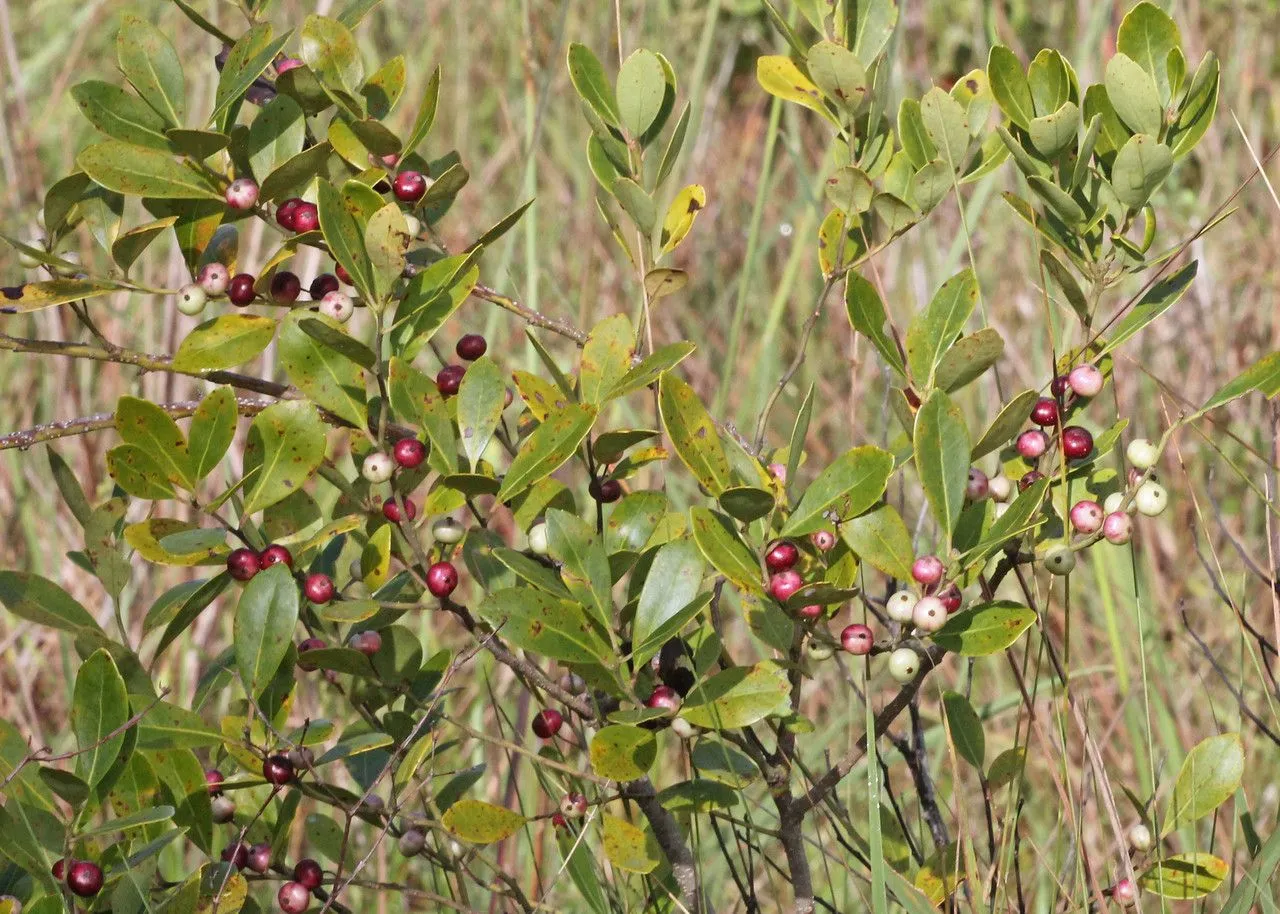
Author: (L.) A.Gray
Bibliography: Manual, ed. 2: 264 (1856)
Year: 1856
Status: accepted
Rank: species
Genus: Ilex
Vegetable: False
Observations: Nova Scotia to Texas
Appalachian-tea, scientifically known as Ilex glabra, is a resilient and versatile plant belonging to the Aquifoliaceae family. This evergreen shrub is indigenous to a wide geographic range, stretching from Nova Scotia in the northeast, all the way down to Texas in the southwest.
Known for its hardy nature, Appalachian-tea thrives in a variety of conditions, making it a popular choice for landscape gardening and natural habitats. The plant typically grows in moist, acidic soils and is commonly found in pine barrens, bogs, and along the edges of wetlands.
Ilex glabra boasts glossy, dark green leaves that remain vibrant throughout the year, providing a reliable touch of greenery regardless of the season. This characteristic makes it particularly valuable for maintaining consistent foliage in gardens and natural settings. The leaves are simple, elliptic to oblanceolate in shape, contributing to its aesthetically pleasing appearance.
During the flowering season, Appalachian-tea produces small, whitish flowers that, while not overly conspicuous, add a delicate beauty to the plant. These blossoms eventually give rise to small, black, berry-like drupes, which not only add visual interest but also serve as a food source for various bird species, thus playing a vital role in local ecosystems.
The resilience and adaptability of Appalachian-tea make it an excellent option for erosion control and as a foundation plant in landscaping. It is also valued for its low maintenance requirements and ability to withstand pruning, facilitating its use in formal garden designs and informal naturalistic plantings alike.
Historically, it has been noted since the mid-19th century, as documented in the second edition of a manual published in 1856. The author, (L.) A.Gray, contributed to the formal recognition and description of this species, establishing a foundation for its botanical and horticultural understanding.
In summary, Appalachian-tea (Ilex glabra) is a robust and attractive evergreen shrub prized for its year-round foliage, adaptability, and ecological benefits. Whether utilized in gardens, for erosion control, or as part of a natural habitat restoration project, this plant is a valuable asset to any landscape.
Eng: appalachian-tea, bitter gallberry, gallberry, inkberry, winter-berry, appalachian tea, canadian winterberry, evergreen winterberry
Deu: tintenbeere, kahle winterbeere
Swe: bläckbärsjärnek
Fra: houx galbre, houx glabre
En: Appalachian-tea, Bitter gallberry, Inkberry, Winter-berry, Gallberry, Lowbush gallberry, Appalachian tea, Canadian winterberry, Evergreen winterberry
Ar: بهشية مرداء
Fi: Kiilto-orjanlaakeri
Fr: Houx Galbre, Houx glabre
De: Tintenbeere, Kahle Winterbeere
Fa: خاس نرم
Sv: Bläckbärsjärnek
Taken Jul 21, 2021 by Friedman Gerald (cc-by-sa)
Taken Jun 9, 2022 by u u (cc-by-sa)
Taken Nov 21, 2021 by F.L. Bezoar (cc-by-sa)
Taken Jan 4, 2020 by Luke Luke (cc-by-sa)
Taken Nov 23, 2021 by Dan Doornbos (cc-by-sa)
Taken May 2, 2021 by Paris B (cc-by-sa)
Taken Jun 9, 2022 by u u (cc-by-sa)
Taken Jun 9, 2022 by u u (cc-by-sa)
Taken Jun 12, 2021 by William Ansley (cc-by-sa)
Taken Jun 19, 2021 by wendy y (cc-by-sa)
Taken Sep 27, 2014 by EOL − Mary Keim (cc-by-nc-sa)
Taken Mar 5, 2015 by EOL − nataliemhowe (cc-by-nc)
Taken Apr 22, 2015 by EOL − jonibaum (cc-by-nc)
Taken Mar 3, 2015 by EOL − Kieran Hunt (cc-by-nc)
Taken May 26, 2011 by EOL − Johnny Wilson (cc-by-nc)
Taken Nov 11, 2021 by Maarten Vanhove (cc-by-sa)
Taken Apr 1, 2022 by FUENTES LUIS (cc-by-sa)
Taken Aug 29, 2021 by Danny DJ (cc-by-sa)
Taken Aug 25, 2020 by J L (cc-by-sa)
Taken Jun 1, 2021 by Heather Anne Walter (cc-by-sa)
Taken Jan 1, 1900 by EOL − Smithsonian Institution, National Museum of Natural History, Department of Botany (cc-by-nc-sa)
Taken Nov 5, 2011 by EOL − Mary Keim (cc-by-nc-sa)
Taken Jan 4, 2020 by Luke Luke (cc-by-sa)
Taken Nov 21, 2021 by F.L. Bezoar (cc-by-sa)
Taken Dec 11, 2021 by Ashley Scholer (cc-by-sa)
Taken Apr 1, 2022 by FUENTES LUIS (cc-by-sa)
Growth form>: Multiple Stem
Growth habit>: Shrub
Growth rate>: Slow
Ph maximum: 7.0
Ph minimum: 4.5
Family: Myrtaceae Author: (F.Muell.) K.D.Hill & L.A.S.Johnson Bibliography: Telopea 6: 402 (1995) Year: 1995 Status:…
Family: Rubiaceae Author: Pierre ex A.Froehner Bibliography: Notizbl. Bot. Gart. Berlin-Dahlem 1: 237 (1897) Year:…
Family: Sapindaceae Author: Koidz. Bibliography: J. Coll. Sci. Imp. Univ. Tokyo 32(1): 38 (1911) Year:…
Family: Asteraceae Author: A.Gray Bibliography: Pacif. Railr. Rep.: 107 (1857) Year: 1857 Status: accepted Rank:…
Family: Fabaceae Author: Medik. Bibliography: Vorles. Churpfälz. Phys.-Ökon. Ges. 2: 398 (1787) Year: 1787 Status:…
Family: Aspleniaceae Author: (Cav.) Alston Bibliography: Bull. Misc. Inform. Kew 1932: 309 (1932) Year: 1932…